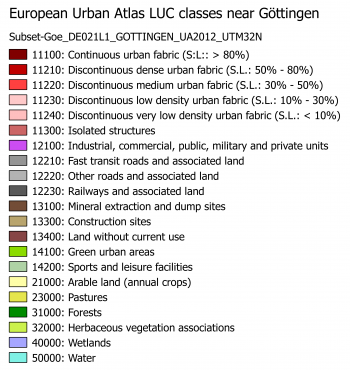Training data selection (SCP)
(→Interpretation of selected points) |
(→Interpretation of selected points) |
||
| Line 113: | Line 113: | ||
* Install the ''Openlayers'' plugin (if not yet done) {{mitem|text=Plugins --> Manage and Install Plugins --> Install}}. | * Install the ''Openlayers'' plugin (if not yet done) {{mitem|text=Plugins --> Manage and Install Plugins --> Install}}. | ||
* Install the ''Go2nextFeature'' plugin. | * Install the ''Go2nextFeature'' plugin. | ||
| − | * Load the multiband Sentinel-2 satellite image as surface reflectance | + | * Load the multiband Sentinel-2 satellite image as surface reflectance(see [[Preparing raster data (Converting DN to reflectance)]]). |
* | * | ||
* Load the vector file with stratified sample points ''stratified_sample_25.shp''. | * Load the vector file with stratified sample points ''stratified_sample_25.shp''. | ||
Revision as of 10:49, 20 April 2018
Contents |
Defining land use/cover classes
Before starting to map land cover classes using Sentinel-2 satellite images we need clear definitions and a classification scheme. An example for a hierarchical land use and land cover (LUC) classification scheme is the European Urban Atlas. The scheme defines 5 meta classes where the class 1. Artificial surfaces has many sub classes as shown in figure A.
The specification of other meta classes is not as detailed. If we are more interested in forest and open area classes we need to adapt and modify this scheme. On the lowest level not all classes defined in the European Urban Atlas do also appear in the surroundings of Göttingen (figure B). In addition we need to consider the phenolgical development of vegetation at specific acquisiton dates and to specify more classes which can possibly be identified in multispectral feature space of the satellite image. An example of an adapted simplified scheme is shown in the table below.
| MC ID | MC info | C ID | C info | RGB code |
|---|---|---|---|---|
| 1 | Artificial surfaces | 11 | Built-up | 230-77-0 |
| 2 | Agricultural | 21 | Arable land | 255-255-168 |
| 2 | Agricultural | 22 | Bare soil | 253-191-111 |
| 2 | Agricultural | 23 | Pasture | 230-230-77 |
| 3 | Natural and semi-natural areas | 31 | Broad leaved tree cover | 128-255-0 |
| 3 | Natural and semi-natural areas | 32 | Coniferous tree cover | 128-255-0 |
| 4 | Wetlands | 41 | Reed | 128-255-0 |
| 5 | Water | 51 | Water | 128-242-230 |
| 9 | Miscellaneous | 91 | No data (cloud) | 255-255-255 |
| 9 | Miscellaneous | 92 | No data (shadow) | 0-0-0 |
| 9 | Miscellaneous | 93 | No data (missing imagery) | 0-0-0 |
Creating systematic sampling grid
- Use a processing toolbox model downloaded from here urban_atlas_systematic_sample.model (Right click, Save as ..). Note, save the file with the extension *.model.
- Open the Processing --> Toolbox and Models --> Tools --> Add model from file. Load the previously downloaded model.
- The model should appear in the Models tab.
- Double click to open the model.
- Specify an original European Urban Vectors layer for Göttingen: geodata_lab01\vector\DE021L1_GOTTINGEN\Subset-Goe_DE021L1_GOTTINGEN_UA2012_UTM32N.shp or download data from other European cities.
- Project --> Project Properties --> CRS. Check that the Project spatial reference system is set to EPSG:32632.
- Click OK
Stratified random sampling
- Vector --> Research Tools --> Random selection within subsets
- The input layer is SCP_systematic_points
- ID Field containing the code for the strata is MC_ID
- Method is equal Number of selected features in each stratum.
- Number of selected features type 25.
The module selects a subset of the layer SCP_systematic_points. The selected points need to be saved as an ESRI shapefile. Right click on the layer SCP_systematic_points, Save as.... Make sure to check the box: 'Save selected only..as shown below.
Interpretation of selected points
Prepare main QGIS map viewer:
- Install the Openlayers plugin (if not yet done) Plugins --> Manage and Install Plugins --> Install.
- Install the Go2nextFeature plugin.
- Load the multiband Sentinel-2 satellite image as surface reflectance(see Preparing raster data (Converting DN to reflectance)).
- Load the vector file with stratified sample points stratified_sample_25.shp.
- Load Google maps as background WMS layer. Web --> OpenLayers Plugin --> Google Maps --> Google Satellite.
- In Layers panel drag the GCP vector file on top of Google Satellite.




